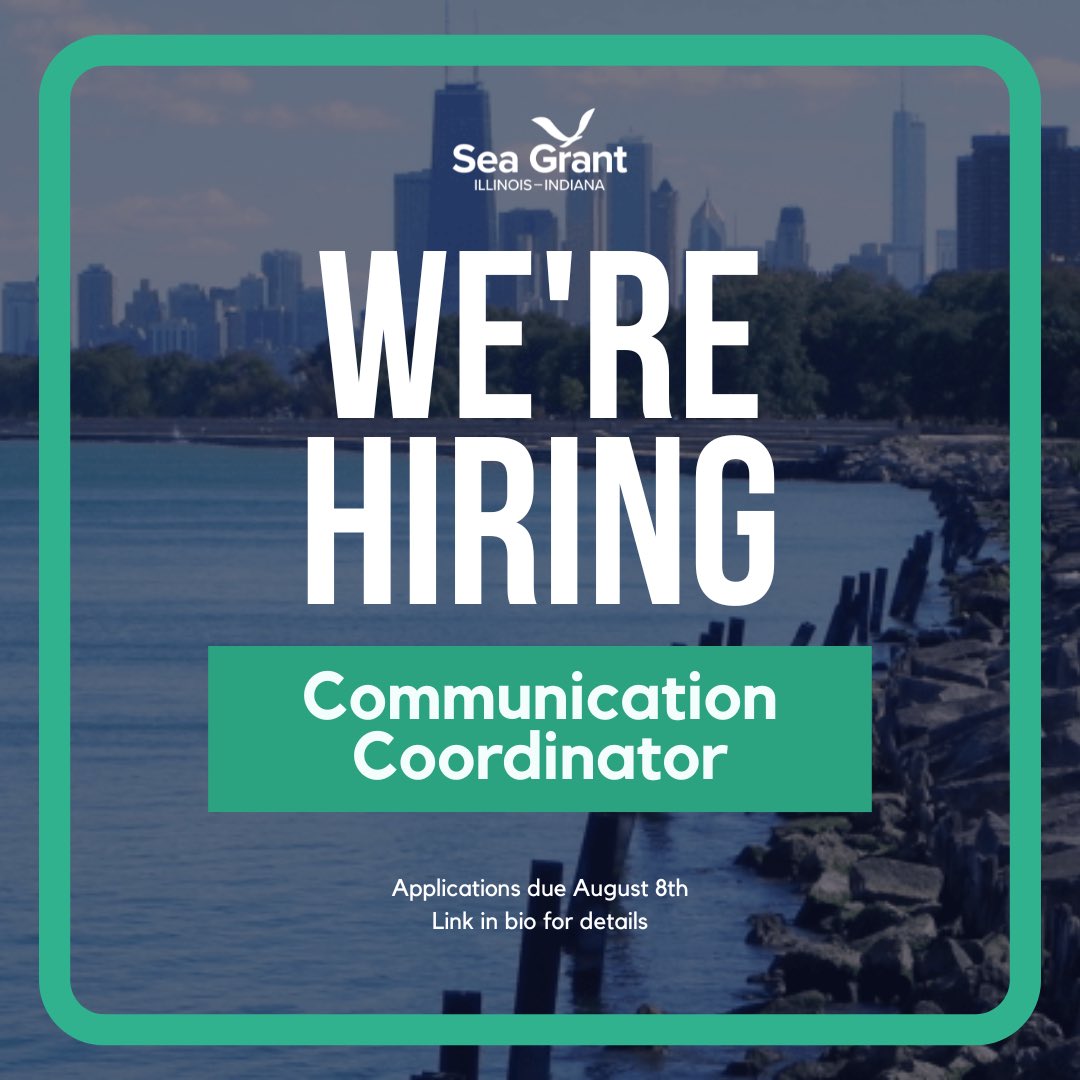May 16th, 2018 by Hope Charters
Not every day do students board a ship and learn about the research conducted out on Lake Michigan. Illinois-Indiana Sea Grant (IISG) Community Outreach Specialist Kristin TePas recently organized tours of the U.S. EPA research vessel, the Lake Guardian, for 140 students and chaperones from four Illinois and Indiana schools.
Students from Chicago’s Dr. Martin Luther King Jr. College Preparatory High School boarded Lake Guardian just off Navy Pier with their science teachers Cheryl Dudeck and Melanie Yau, who in previous summers, completed a week-long shipboard science teacher workshop on the research vessel. Earlier in the day, Deb Broom’s class at Portage High School in Portage, Ind., and Marta Johnson’s students from South Shore International College Prep in Chicago toured the ship as well.

While aboard Lake Guardian, students learned from the ship’s crew about aquatic invasive species like quagga mussels in the Great Lakes, got a hands-on experience with research samples, and met the ship’s captain. The crew shared with students stories about life on the ship and demonstrated the equipment researchers use to monitor water quality on the lake. Paris Collingsworth, IISG Great Lakes ecosystem specialist, was on board to share some recent research findings.

Middle school students from Discovery Charter School in Porter, Ind., also joined their science teacher Amanda Renslow aboard the research vessel. In addition to the ship tour, Renslow’s students engaged in a beach cleanup at nearby Ohio Street beach. Students tracked each item of trash they collected for further discussions about recycling and sustainability back in the classroom.
Alongside the beach, Allison Neubauer, IISG Great Lakes outreach associate, led an activity for the Discovery School students to guess how long common items thrown in the trash, like juice containers and newspaper, take to break down in the environment.
For more information about the research vessel, including information about ongoing projects, visit Lake Guardian.
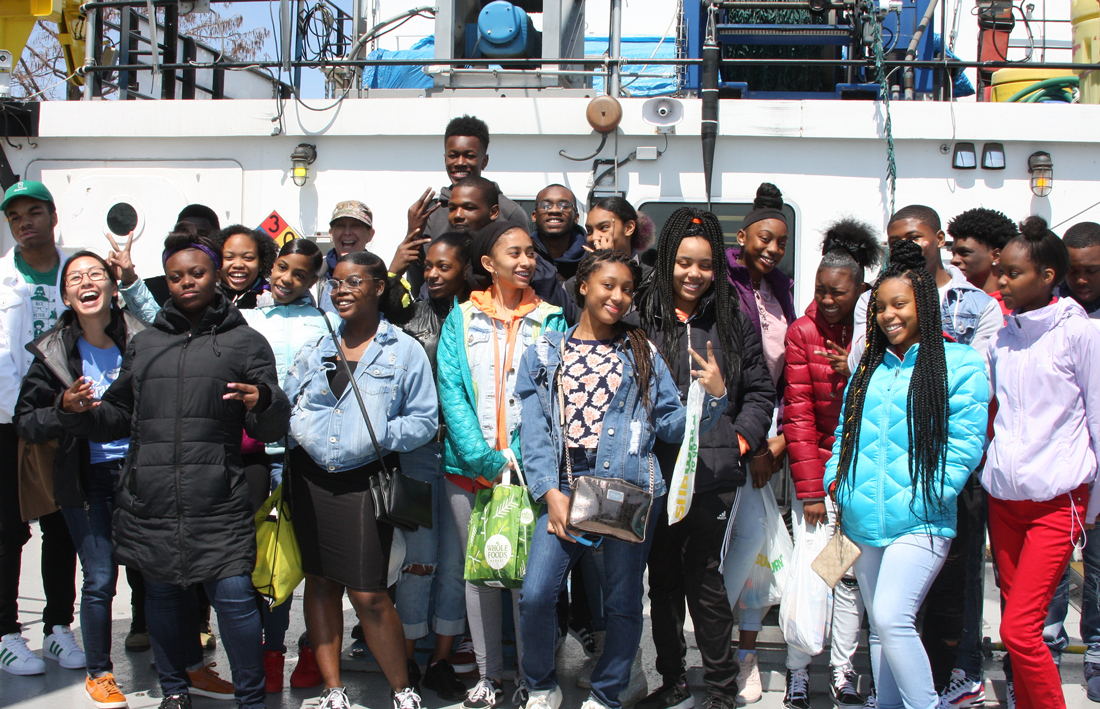
March 13th, 2018 by Hope Charters
Drawing on the rich Sea Grant talent pool around the country, Illinois-Indiana Sea Grant (IISG) welcomes our newest addition, Stuart Carlton, as the program’s assistant director. Previously a healthy coastal ecosystems and social science specialist with Texas Sea Grant, he now manages day-to-day operations and, working closely with director Tomas Höök and the IISG team, coordinates all aspects of the program.
“As assistant director, my main job is to guide and support our staff as they continue to do amazing work,” said Carlton. “Our specialists are experts in their field; my goal is to empower them and then get out of the way.”
Carlton also hopes to help expand the program and create new partnerships for IISG in the Great Lakes region and beyond. “Environmental issues are complex, a fact that isn’t going to change any time soon,” he said. “We need to be constantly thinking about who we can work with to meet 21st-century challenges.”
Carlton is an interdisciplinary social scientist who holds a PhD in interdisciplinary ecology from the 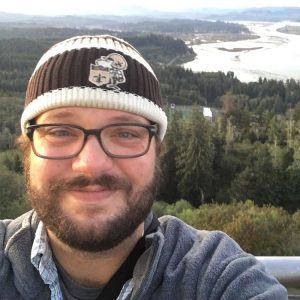 University of Florida, an MS in fisheries biology from the University of Georgia, and a BS in English from Tulane University. In addition to Texas Sea Grant, he has held positions at Florida Sea Grant and the Natural Resources Social Science Lab in Purdue’s Department of Forestry and Natural Resources.
University of Florida, an MS in fisheries biology from the University of Georgia, and a BS in English from Tulane University. In addition to Texas Sea Grant, he has held positions at Florida Sea Grant and the Natural Resources Social Science Lab in Purdue’s Department of Forestry and Natural Resources.
“Illinois-Indiana Sea Grant is never boring,” he said. “We work on issues ranging from aquatic invasive species to medicine disposal, green infrastructure, aquaculture, climate change, community planning, environmental education and beyond. We fund groundbreaking biological, ecological and social science research. We have buoys. The sheer number of cool, important things that we do is mind-blowing.”
His research and outreach interests are in the role of stakeholder values, attitudes, and behaviors in controversial environmental systems. Carlton has worked on a variety of issues, ranging from snapper management in the Gulf of Mexico to state service foresters’ use of climate information. His research on climate change beliefs has been cited on the Senate floor, covered by national and international media—including The Guardian and The Washington Post—and has been featured as the top post on the front page of Reddit.
“I enjoy working for Sea Grant because I strongly believe in our mission to provide unbiased, research-based information to help people and communities become more resilient and sustainable,” said Carlton. “We take the important work that scientists are doing and use it to actually help people and communities, and that’s pretty neat.”
February 21st, 2018 by Hope Charters
Tomas Höök has taken the lead as director of Illinois-Indiana Sea Grant, managing program administration at Purdue University after the transition from University of Illinois. Höök, who has been with IISG since 2010, was previously the program’s associate director of research. He replaces Brian Miller, who served as IISG director for the past ten years.
“As director, I initially hope to help guide the program through the transition period as our administration moves from Illinois to Purdue and new staff members come on board, all while dealing with uncertain federal funding scenarios,” Höök said. “Eventually, I’d like to help our program develop new initiatives, partnerships and approaches to help inform and empower Illinois and Indiana communities.”
Höök holds an appointment as associate professor of fisheries and aquatic sciences in the Department of Forestry and Natural Resources at Purdue University. He directs a Purdue research lab that investigates environmental questions at the interface between applied and basic ecology, focusing on fish and fisheries ecology in the Great Lakes.
“Purdue is thrilled that Dr. Tomas Hook will serve as the next director of Illinois-Indiana Sea Grant,” said Robert Wagner, head of Purdue’s Department of Forestry and Natural Resources. “Tomas brings outstanding previous experience with IISG, as well as incredible expertise, to this leadership position. We are happy to once again serve as the lead institution for the next phase of Illinois-Indiana Sea Grant.”
Höök grew up in Sweden but completed high school in Alabama when his family moved to the United States and he now holds dual citizenship in both countries. He received his BS, MS and PhD from the University of Michigan. Prior to joining IISG and Purdue University, he worked at the Cooperative Institute for Limnology and Ecosystems Research (now known as CIGLR) and as a visiting scientist at Stockholm University in Sweden. Höök is also a former president of the International Association for Great Lakes Research.
“I enjoy working with IISG because I believe our program makes a real difference through applied research and engagement, thereby facilitating communities in Illinois and Indiana to improve quality of life and environmental conditions around Lake Michigan,” said Höök. “I also appreciate that IISG staff members are a dedicated, knowledgeable and fun bunch to work with.”
February 13th, 2018 by Hope Charters
Brian Miller has been director of the Illinois-Indiana Sea Grant program for 10 years. He retired on February 1, 2018, as the program administration transitioned from the University of Illinois to Purdue University. Below is an interview from his final days with IISG.
What is your history with the IISG program?
I started back in 1994 as the extension program leader. The program began at the University of Illinois, and in 1994, it came to Purdue when the university asked for the opportunity to take a shot at running the administration. At that time, IISG was very small. There was no research program, the director, Phil Pope, was from Purdue’s Department of Forestry and Natural Resources.
We got the research program reinstated, and in 1997 we achieved college status. In 2001, when Phil Pope retired, the two universities agreed that it would move to the University of Illinois to report to the vice chancellor of research.
Then, in 2007 I was hired as the director. When I was getting ready to retire, the same discussions came up that happened back in 1994 and in 2001. We’ve again decided to move the program to the partner university, so, we’ve really come full circle. The difference is that when it came to Purdue the first time, there were four people, one specialist, and a budget of about $300 thousand per year with no research. And nobody really knew who we were or what we did. It was hard to become a partner in a big place like Chicago. People in the universities didn’t know what to do with us, and people on the coast didn’t know what to do with us. It was just a small program.
Today, the program is coming over to Purdue with 18 specialists and more than 175 partners. I think the big thing that’s changed is that we no longer have to walk through the door and explain what we do, and we don’t have to try to convince people to work with us. In a lot of cases, it goes the other way, where we’re asked to help participate and solve problems. We’re seen as a program that can bring science and expertise to bear on tough community, state, and regional resource issues. And that really was the dream initially. So, I think that provides a pretty good platform for moving forward with the next administration.
What have been IISG’s greatest impacts during your time as director?
I think one of the things that we’re known for nationally is that we help local communities with planning, whether it’s watershed planning, land use planning, sustainable water planning, or thinking about planning for hazards and how to be resilient so we’re not more susceptible to flooding. We try to make sure that everything we do helps somebody make a decision—about management or policy or even personal decisions—that balances their goals with what’s best for the coast.
I’m pretty proud of the connection we’ve made between universities and communities. Researchers now have the ability to take their results and, instead of just depositing them somewhere like publications or the library, they can incorporate them into a decision support system that communities can use. Three great examples of that are GreatLakesMonitoring.org, Tipping Point Planner, and Great Lakes to Gulf.
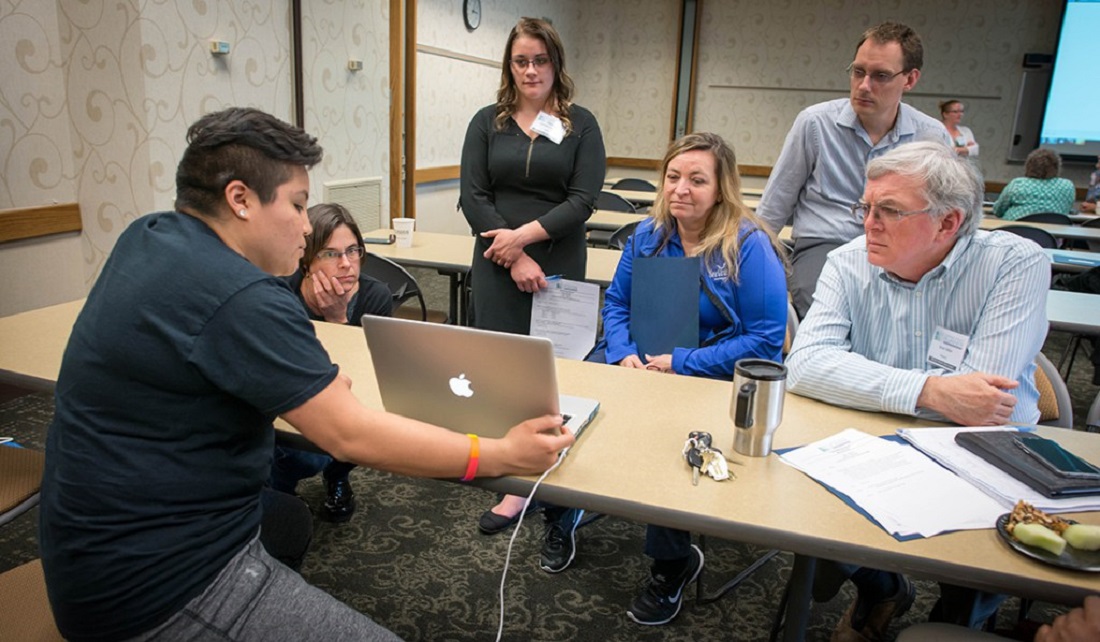
Brian Miller, right, listens as Purdue University graduate student Valeria Mijares talks about research on comprehensive indicators of water quality. Seated from left are Sherry Martin, research associate, Michigan State University, Danielle Gerlach, Michigan Sea Grant intern, Mary Bohling, extension educator, and Dan Walker, IISG community planning extension specialist.
The last big project I got involved with was the Illinois Nutrient Loss Reduction Strategy. That was one of the most challenging projects, but it was also the most rewarding. I was asked to help facilitate the process to develop and implement a nutrient loss reduction strategy in Illinois. The Illinois Water Resources Center and IISG really work together on this. I am proud of facilitating a policy workgroup, made up of a wide array of stakeholders that were able to come together and develop a solution. We had seven workgroups, and in two years we were able to publish the Illinois Nutrient Loss Reduction Strategy.
Last August, we released our first biannual report that demonstrated big changes in land use practices and best management practices along with a scientific report that showed a reduction in the loss of nutrients in the state. It was really rewarding to see people coming together to solve problems, and willing to try and make sure they’re protecting the water and the environment we all share. That experience was kind of a capstone that brought together all of my experiences and knowledge during my time with Sea Grant.
What has it meant to you to be part of the Sea Grant network?
When I started in 1994, the very first meeting I met my peers at other Sea Grant institutions, we just all immediately became friends. Through my whole career, that feeling never changed. There were often national competitions for money or national research competitions where we could’ve easily become competitors and fought with each other, but we never did. In the Great Lakes, there’s been a long tradition of networking and partnering.
Something I really appreciate from the Sea Grant network is that we are all based at the core in university science. We start with the facts. We may have different ideas of how to get there, but we’re able to find a way to do it together for the greatest impact. Over the years, the focus has shifted from “How many pubs did you create?” to “So, what did it do? How was it used? Did the environment change because of what you did?” That was a very different way of thinking, and I think Sea Grant was one of the leading agencies and groups to embrace that.
One of the coolest things that I got involved with was creating the Sea Grant Academy. Up until the late ‘90s and early 2000s, there was nowhere to learn how to focus on impacts, to learn how to plan new programs, and to get the ethos of what a good extension or Sea Grant program should really be. And so, we decided to develop an academy. It’s been conducted every two years since then. After our third academy, 10 percent of all the program leaders were academy graduates. And I think that number is higher now.
Two of the cornerstones of academy training is how to design programs for impact and to learn how to report to Congress and your state legislators and communities with demonstrated impacts. And I think that’s just a philosophy that always gave purpose and meaning to me personally. That seems to be the philosophy that drives Sea Grant, and I think that’s what being part of that network has meant to me.
What will you miss most about being involved with IISG?
The people. The thing that has always been so special about Sea Grant is the people. There’s an old cliché and you hear it a lot: “We’re like family,” but it really is like that with IISG. There is always a cooperative spirit. We all work together. It doesn’t matter that we work in separate states. It doesn’t matter that we have different universities. It doesn’t matter that, in all other aspects, we would be competing for resources. But because we are part of Sea Grant, we work together, we get credit for working together, and we know that we’re stronger for doing that.
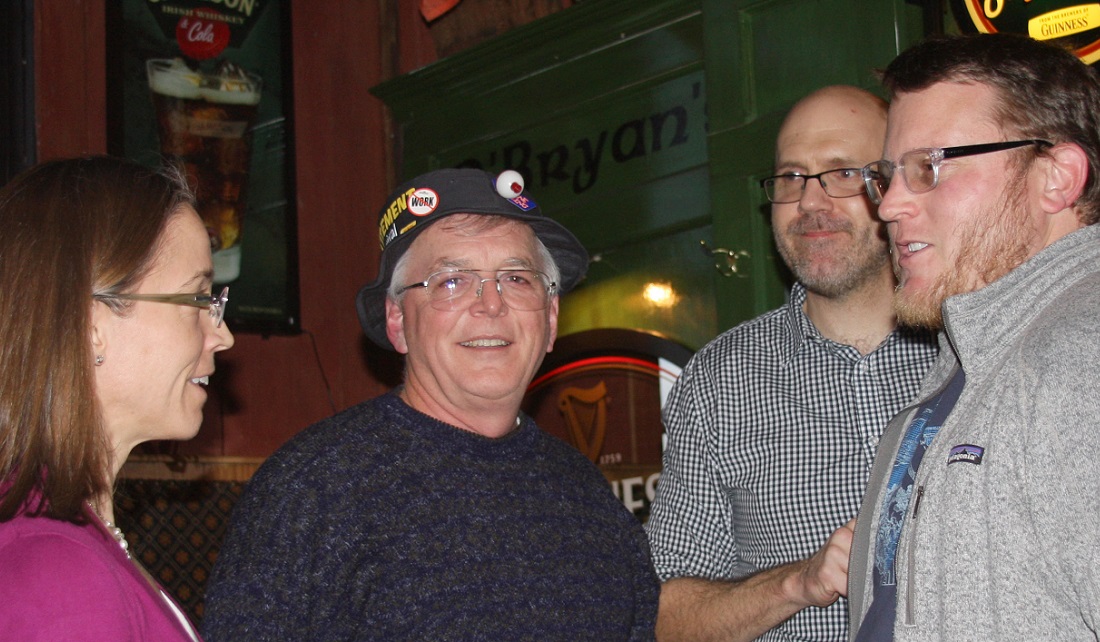
IISG staff members, Kristin TePas and Tomas Hook, and former IISG employee, Jarrod Doucette, reminiscing with Brian Miller at his retirement party.
We respect each other as colleagues and friends. I’ve appreciated that throughout my entire career. It’s added a lot of value to my memories, my career satisfaction, and everyone I’ve gotten to know has added to my perspective of how I view the world and how to operate in it. That’s something that I’ll really miss. You don’t get that in every career.
What are your plans after retiring?
I grew up in southern Indiana. Both my grandparents farmed. I was raised as a kid spending all my summers on the farm, and that’s where I got involved in wildlife and forestry and water resources. Then, I came to Purdue and got a degree and became a wildlife biologist. I worked in Connecticut as a wild turkey and small game biologist and then came back to Purdue to work as a wildlife extension specialist. I started to realize that just working on wildlife habitat wasn’t good enough–I realized that if we weren’t working with land use planning, we weren’t going to solve any problems.
Then Sea Grant really helped me broaden into water, fisheries, and coastal issues. So, I went from being a specialist to being a generalist really. But toward the end of my career, I also got involved in farming and nutrient issues. Now, as I retire, I’m going back to the farm that’s been in my family for 150 years, and it’s got a house on it that was built in 1905. I’ve added wetlands, and I have short grass prairie and tall grass prairie. I have mature woodlands, and I’ve planted bottom land hardwoods. And now, I have the chance to put a lot of what I’ve done and learned back into practice with my own hands again. In a lot of ways, it’s all kind of come full circle.
* This interview has been edited for brevity and clarity.
February 5th, 2018 by Hope Charters
WEST LAFAYETTE, Ind. – Purdue University will administer the Illinois-Indiana Sea Grant College Program (IISG), previously managed by the University of Illinois, effective Feb. 1, 2018. New IISG director Tomas Höök, a fisheries biologist in Purdue’s Department of Forestry and Natural Resources, will lead the administration.
IISG research, outreach and education efforts bring the latest science to southern Lake Michigan residents and decision makers and empower them to secure a healthy environment and economy.
The program has been a leader in the region on aquatic invasive species control, pollution prevention and Great Lakes literacy, and has developed decision tools that help communities grow while protecting natural resources. Illinois-Indiana Sea Grant supports more than 50 permanent medicine collection programs in the Great Lakes region, has helped the Indiana aquaculture industry grow fivefold and provides resources for municipalities to plan for future water supplies.
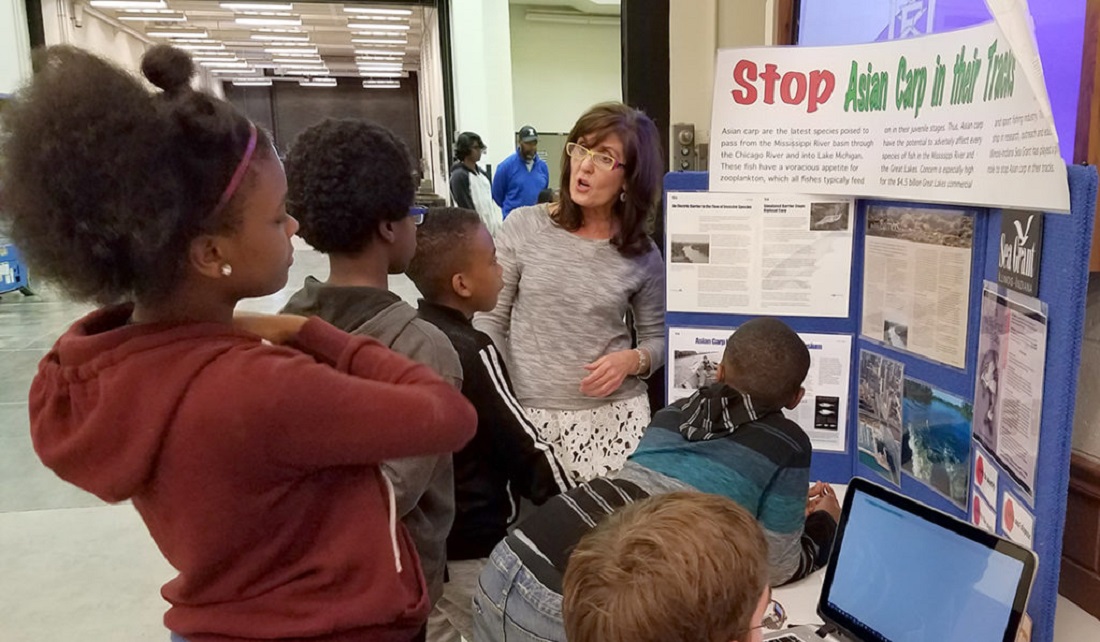
Terri Hallesy, IISG education coordinator, engages elementary students at the University of Illinois’ Brady STEM Academy about the threat of Asian carp to the Great Lakes.
IISG is funded through the National Oceanic and Atmospheric Administration (NOAA), Purdue University and the University of Illinois.
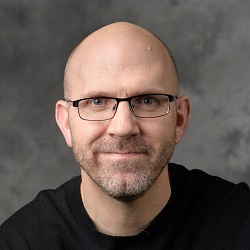
Tomas Höök, Director
“While Illinois-Indiana Sea Grant has recently been administered by the University of Illinois, it has always been a truly bi-state program,” says Höök, who has served as IISG’s associate director for research since 2010. “For the past 16 years, the program has greatly benefitted from IISG leadership at Illinois, especially Brian Miller and Lisa Merrifield. With program administration moving to Purdue, IISG will continue to work to empower Lake Michigan communities in both Illinois and Indiana through applied discovery and information dissemination.”
Purdue University and the University of Illinois have worked closely to oversee IISG since 1982, periodically transferring the program directorship. Over its 36 years, the program has maintained an administrative presence at both universities.
“When I started my career with Sea Grant in 1994, we were going through an administrative transition similar to the one happening right now,” says Brian Miller, who has been program director for 11 years and is now retiring. “What we have accomplished since that time provides a wonderful platform for even greater growth in the future.”
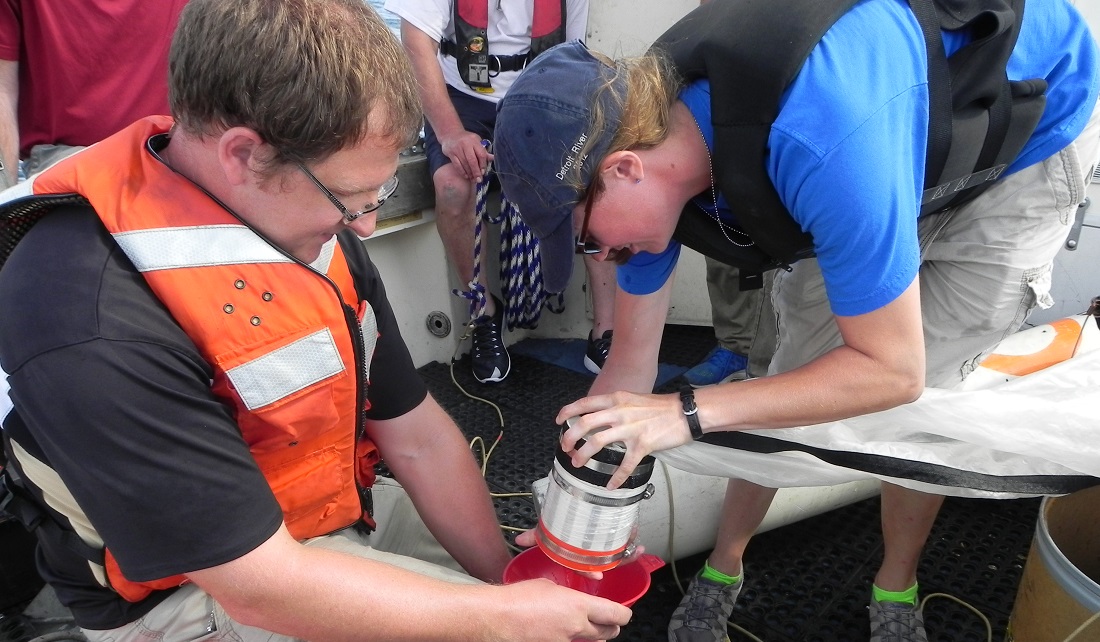
IISG Aquatic Ecologist Jay Beugly helps Purdue University student Margaret Hutton sample Lake Michigan water near Wilmette, Illinois.
IISG is part of the National Sea Grant College program, established in 1966 to protect and preserve America’s coastline and water resources to create a sustainable economy and environment. The network consists of a partnership between NOAA and 33 university-based programs in every coastal and Great Lakes state.




 University of Florida, an MS in fisheries biology from the University of Georgia, and a BS in English from Tulane University. In addition to Texas Sea Grant, he has held positions at Florida Sea Grant and the Natural Resources Social Science Lab in Purdue’s Department of Forestry and Natural Resources.
University of Florida, an MS in fisheries biology from the University of Georgia, and a BS in English from Tulane University. In addition to Texas Sea Grant, he has held positions at Florida Sea Grant and the Natural Resources Social Science Lab in Purdue’s Department of Forestry and Natural Resources.




